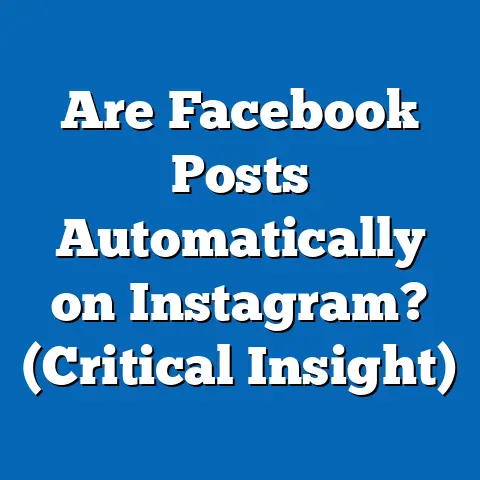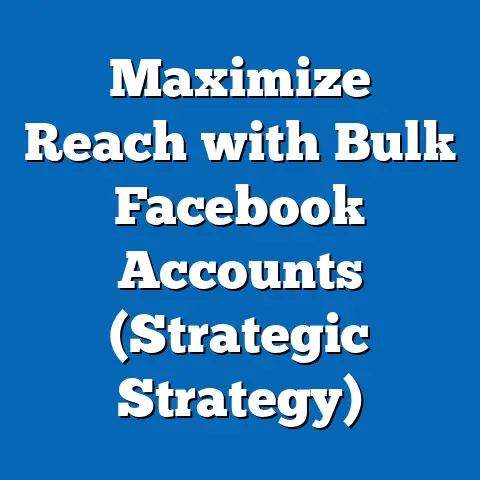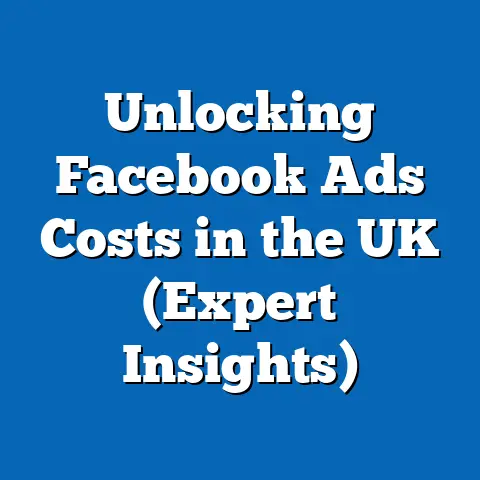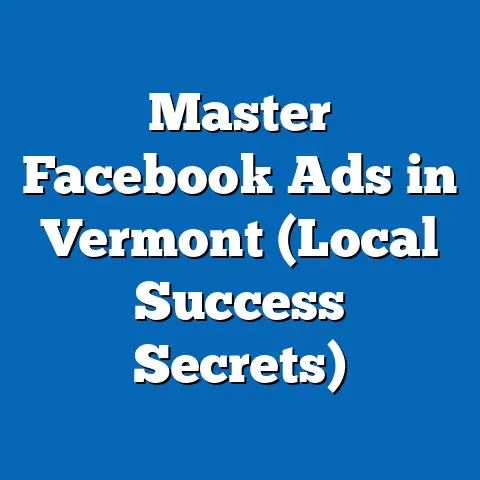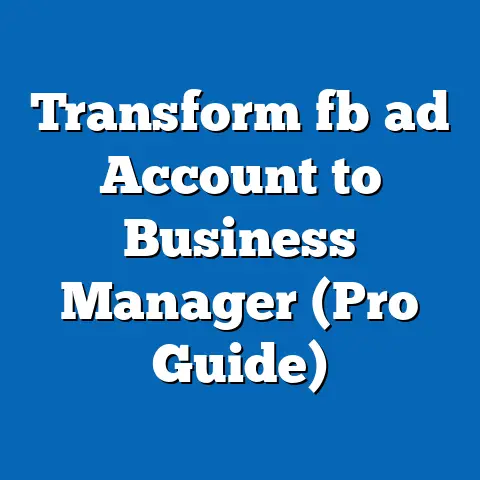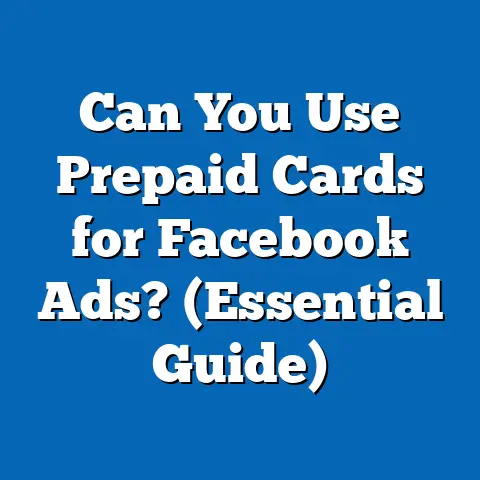Maximize Affiliate Ads Success (Expert Facebook Strategies)
Affiliate marketing can feel like navigating a vast ocean, with the promise of treasure lurking beneath the surface. But without the right map and compass, you’re likely to drift aimlessly. One of the most powerful tools in an affiliate marketer’s arsenal is Facebook advertising. Not just any Facebook ad, mind you, but strategically crafted campaigns that understand the true value of a customer – their resale value.
Think about it: a single conversion isn’t the end goal. It’s the beginning of a potential long-term relationship. It’s about building a loyal customer base that continues to generate revenue over time. That’s where the concept of resale value comes in, and it’s something I’ve learned to prioritize in my own affiliate ventures.
I remember when I first started dabbling in affiliate marketing, I treated each sale as a one-off event. I was so focused on immediate ROI that I completely overlooked the potential for future revenue. My campaigns were a revolving door of new customers, and I was constantly scrambling to find the next quick win. It was exhausting and, frankly, not very profitable.
Then, I stumbled upon the idea of resale value – the potential for future purchases from the same customer. It was a lightbulb moment. I realized that by nurturing customer relationships and focusing on long-term value, I could create a more sustainable and profitable business. That’s when I started to see real success.
Facebook, with its massive user base and sophisticated targeting capabilities, is the perfect platform to implement this strategy. In fact, according to Statista, Facebook’s advertising revenue reached nearly $117 billion in 2022, demonstrating its continued dominance in the digital advertising landscape. This means there’s a huge audience ready to be tapped into, but only if you know how to do it right.
Key Takeaway: Affiliate marketing isn’t just about making a quick buck. It’s about building a loyal customer base that generates long-term revenue. Understanding and leveraging resale value is the key to unlocking sustainable success.
Section 1: Understanding the Facebook Advertising Ecosystem
Before you can launch a successful affiliate campaign, you need to understand the ins and outs of the Facebook advertising ecosystem. It’s a complex system with a lot of moving parts, but once you grasp the fundamentals, you’ll be well on your way to creating high-performing ads.
Overview of Facebook Ads
Facebook offers a variety of ad formats, each with its own strengths and weaknesses. Choosing the right format is crucial for achieving your campaign goals. Here’s a breakdown of some of the most popular options:
- Image Ads: These are the simplest and most common type of Facebook ad. They consist of a single image, ad copy, and a call-to-action button. Image ads are great for showcasing products, promoting events, or driving traffic to your website.
- Video Ads: Video ads are more engaging than image ads and can be used to tell a story, demonstrate a product, or build brand awareness. They can be short and sweet or longer and more informative.
- Carousel Ads: Carousel ads allow you to showcase multiple images or videos in a single ad unit. This format is ideal for highlighting different aspects of a product, showcasing a range of products, or telling a story in a visually appealing way.
- Collection Ads: Collection ads are designed for e-commerce businesses and allow you to showcase a catalog of products in a visually appealing format. When users click on a collection ad, they’re taken to a full-screen experience where they can browse and purchase products.
- Instant Experience Ads (formerly Canvas Ads): These are full-screen, mobile-optimized ads that provide an immersive experience for users. They can include images, videos, carousels, and interactive elements. Instant Experience ads are great for telling a brand story or showcasing a product in detail.
When I’m deciding on an ad format, I always consider my target audience and the message I want to convey. For example, if I’m promoting a complex product, I might opt for a video ad to demonstrate its features and benefits. If I’m showcasing a range of products, a carousel ad would be a better choice.
Key Takeaway: Facebook offers a variety of ad formats, each with its own strengths and weaknesses. Choose the right format based on your target audience and the message you want to convey.
Targeting Capabilities
One of the biggest advantages of Facebook advertising is its advanced targeting capabilities. You can target users based on a wide range of factors, including:
- Demographics: Age, gender, location, education, relationship status, and more.
- Interests: Hobbies, interests, and activities that users have expressed on Facebook.
- Behaviors: Past purchase behavior, website activity, and other online behaviors.
- Custom Audiences: You can upload your own customer data (e.g., email addresses, phone numbers) to create custom audiences. This allows you to target your existing customers or create lookalike audiences (users who are similar to your existing customers).
- Lookalike Audiences: As mentioned above, lookalike audiences are a powerful way to reach new customers who are likely to be interested in your products or services. Facebook uses its data to identify users who share similar characteristics with your existing customers.
The key to successful targeting is to be as specific as possible. The more narrowly you define your target audience, the more relevant your ads will be, and the higher your conversion rates will be. This also directly impacts resale value. By targeting the right people from the start, you’re more likely to attract customers who will continue to purchase from you in the future.
I’ve found that creating detailed buyer personas is extremely helpful in defining my target audiences. A buyer persona is a semi-fictional representation of your ideal customer, based on research and data about your existing customers. By creating buyer personas, you can gain a deeper understanding of your target audience’s needs, motivations, and behaviors, which will help you create more effective ads.
Key Takeaway: Facebook’s advanced targeting capabilities allow you to reach a highly specific audience. Use this to your advantage by creating detailed buyer personas and targeting users based on their demographics, interests, behaviors, and more.
Facebook Pixel and Tracking
The Facebook Pixel is a small piece of code that you install on your website. It allows you to track the actions that users take on your website after clicking on your Facebook ad. This data is invaluable for optimizing your ad campaigns and improving your ROI.
Here’s how the Facebook Pixel works:
- Installation: You install the Facebook Pixel code on your website.
- Tracking: When a user clicks on your Facebook ad and visits your website, the Pixel tracks their actions, such as page views, add-to-carts, and purchases.
- Data Collection: The Pixel sends this data back to Facebook, where it’s used to optimize your ad campaigns.
- Retargeting: You can use the Pixel data to retarget users who have visited your website but haven’t yet made a purchase.
The Facebook Pixel is essential for several reasons:
- Conversion Tracking: It allows you to track the conversions that result from your Facebook ads. This helps you understand which ads are performing well and which ones need improvement.
- Retargeting: It allows you to retarget users who have visited your website but haven’t yet made a purchase. This is a highly effective way to increase your conversion rates.
- Optimization: It provides Facebook with the data it needs to optimize your ad campaigns. Facebook uses this data to show your ads to the users who are most likely to convert.
- Understanding Customer Behavior: The Pixel provides insights into how users interact with your website after clicking on your ad. This can help you improve your website design and user experience.
I always make sure to install the Facebook Pixel on every website I use for affiliate marketing. It’s a simple step that can have a huge impact on your campaign performance.
Key Takeaway: The Facebook Pixel is an essential tool for tracking conversions, retargeting users, and optimizing your ad campaigns. Make sure to install it on your website.
Ad Budgeting and Bidding Strategies
Budgeting and bidding are crucial aspects of Facebook advertising. You need to set a budget that’s realistic and sustainable, and you need to choose a bidding strategy that aligns with your campaign goals.
Here are a few things to keep in mind when budgeting for Facebook ads:
- Start Small: When you’re first starting out, it’s best to start with a small budget and gradually increase it as you see results. This will help you minimize your risk and avoid wasting money on ineffective ads.
- Set a Daily or Lifetime Budget: You can set a daily budget, which is the average amount you’re willing to spend each day, or a lifetime budget, which is the total amount you’re willing to spend over the entire campaign.
- Consider Your Target Audience: The size and competitiveness of your target audience will affect your ad costs. If you’re targeting a large and competitive audience, you’ll need to spend more to reach them.
- Track Your ROI: It’s essential to track your return on investment (ROI) to ensure that your ad campaigns are profitable. If you’re not seeing a positive ROI, you need to adjust your budget or your targeting strategy.
Facebook offers several bidding strategies, including:
- Lowest Cost: This is the default bidding strategy. Facebook will try to get you the most results for your budget.
- Cost Cap: This allows you to set a maximum cost per result. Facebook will try to get you results at or below your cost cap.
- Target Cost: This allows you to set a target cost per result. Facebook will try to get you results as close to your target cost as possible.
- Bid Cap: This allows you to set a maximum bid for each auction. This is useful if you want to control your costs and avoid overspending.
The best bidding strategy for you will depend on your campaign goals and your budget. If you’re focused on maximizing your reach, the lowest cost strategy might be the best choice. If you’re focused on controlling your costs, the cost cap or bid cap strategies might be a better fit.
I typically start with the lowest cost strategy and then experiment with other strategies as my campaigns progress. It’s important to monitor your results closely and adjust your bidding strategy as needed.
Key Takeaway: Budgeting and bidding are crucial aspects of Facebook advertising. Set a realistic budget, choose a bidding strategy that aligns with your campaign goals, and track your ROI to ensure that your ad campaigns are profitable.
Section 2: Crafting Compelling Affiliate Ads
Now that you understand the fundamentals of the Facebook advertising ecosystem, it’s time to focus on crafting compelling ads that capture attention, generate interest, and drive conversions. This is where creativity and understanding your audience truly come into play.
Creating Engaging Ad Copy
Your ad copy is the first thing that users will see, so it’s crucial to make it engaging and persuasive. Here are a few tips for writing effective ad copy:
- Know Your Audience: Understand your target audience’s needs, wants, and pain points. Use this knowledge to craft copy that resonates with them.
- Highlight the Benefits: Focus on the benefits of your product or service, not just the features. Explain how it will solve your target audience’s problems or improve their lives.
- Use Strong Headlines: Your headline is the most important part of your ad copy. It needs to grab attention and entice users to click on your ad. Use strong, action-oriented words and phrases.
- Create a Sense of Urgency: Encourage users to take action immediately by creating a sense of urgency. Use phrases like “limited time offer” or “while supplies last.”
- Keep it Concise: People have short attention spans, so keep your ad copy concise and to the point. Get your message across quickly and effectively.
- Use Social Proof: Include testimonials, reviews, or social proof to build trust and credibility.
- Speak Their Language: Use the same language and tone that your target audience uses. This will help you connect with them on a deeper level.
I always try to put myself in my target audience’s shoes when writing ad copy. What are their biggest challenges? What are their aspirations? What kind of language do they use? By answering these questions, I can craft copy that speaks directly to their needs and motivations.
Key Takeaway: Your ad copy is the first thing that users will see, so make it engaging and persuasive. Know your audience, highlight the benefits, use strong headlines, create a sense of urgency, and keep it concise.
Visual Elements
Visual elements play a crucial role in the success of your Facebook ads. A compelling image or video can grab attention, convey your message, and drive conversions.
Here are a few tips for selecting effective visuals:
- Use High-Quality Images and Videos: Avoid using blurry or pixelated images or videos. Use high-quality visuals that are visually appealing and professional.
- Choose Relevant Visuals: Make sure your visuals are relevant to your ad copy and your product or service.
- Use Eye-Catching Visuals: Use visuals that are visually appealing and stand out from the crowd. Consider using bright colors, bold graphics, or interesting compositions.
- Showcase Your Product: If you’re selling a product, showcase it in your visuals. Show people using your product and enjoying its benefits.
- Use Emotionally Evocative Visuals: Use visuals that evoke emotions, such as happiness, excitement, or inspiration. This can help you connect with your target audience on a deeper level.
- Test Different Visuals: Experiment with different visuals to see what works best for your target audience.
I’ve found that using visuals that feature real people is often more effective than using stock photos. People connect with other people, so showing real people using your product or service can help build trust and credibility.
Key Takeaway: Visual elements play a crucial role in the success of your Facebook ads. Use high-quality, relevant, and eye-catching visuals that showcase your product or service and evoke emotions.
Call-to-Action (CTA)
Your call-to-action (CTA) is the final piece of the puzzle. It tells users what you want them to do after seeing your ad. A strong CTA can significantly improve your click-through rates and conversions.
Here are a few tips for creating effective CTAs:
- Use Action-Oriented Words: Use words that encourage users to take action, such as “Shop Now,” “Learn More,” “Sign Up,” or “Download.”
- Make it Clear and Concise: Your CTA should be clear and concise. Tell users exactly what you want them to do.
- Create a Sense of Urgency: Encourage users to take action immediately by creating a sense of urgency. Use phrases like “limited time offer” or “while supplies last.”
- Make it Visually Appealing: Your CTA should be visually appealing and stand out from the rest of your ad. Use a contrasting color or a bold font.
- Test Different CTAs: Experiment with different CTAs to see what works best for your target audience.
I always try to make my CTAs as specific as possible. Instead of using a generic CTA like “Learn More,” I might use a more specific CTA like “Download Your Free Guide” or “Get 20% Off Now.”
Key Takeaway: Your call-to-action (CTA) tells users what you want them to do after seeing your ad. Use action-oriented words, make it clear and concise, create a sense of urgency, and make it visually appealing.
A/B Testing
A/B testing is a powerful technique for optimizing your Facebook ads. It involves creating two versions of an ad (A and B) and testing them against each other to see which one performs better.
You can A/B test different elements of your ads, such as:
- Headlines: Test different headlines to see which one grabs the most attention.
- Ad Copy: Test different ad copy to see which one is most persuasive.
- Visuals: Test different images or videos to see which one resonates best with your target audience.
- CTAs: Test different CTAs to see which one generates the most clicks.
- Targeting: Test different targeting options to see which one reaches the most relevant audience.
To conduct an A/B test, you need to create two versions of your ad that are identical except for the element you’re testing. For example, if you’re testing headlines, you would create two ads with different headlines but the same ad copy, visuals, and CTA.
Once you’ve created your ads, you need to run them for a sufficient amount of time to gather statistically significant data. This means that you need to run your ads long enough to ensure that the results are not due to chance.
After you’ve gathered enough data, you can analyze the results to see which ad performed better. The ad that performed better is the winner, and you should use it in your future campaigns.
I’m a firm believer in the power of A/B testing. It’s the best way to determine what works and what doesn’t. I’m constantly A/B testing different elements of my ads to improve their performance.
Key Takeaway: A/B testing is a powerful technique for optimizing your Facebook ads. Test different elements of your ads to see what works best for your target audience.
Section 3: Building a Profitable Affiliate Funnel
Crafting compelling ads is only half the battle. You also need to build a profitable affiliate funnel that guides potential customers through the buying process. This involves creating high-converting landing pages, integrating email marketing, and understanding the customer journey.
Creating Landing Pages
Your landing page is the first thing that users will see after clicking on your Facebook ad. It’s crucial to create a landing page that is visually appealing, informative, and persuasive.
Here are a few tips for creating high-converting landing pages:
- Match Your Ad Copy: Your landing page should match your ad copy in terms of tone, style, and message. This will create a seamless experience for users and increase the likelihood that they’ll convert.
- Highlight the Benefits: Focus on the benefits of your product or service, not just the features. Explain how it will solve your target audience’s problems or improve their lives.
- Use Strong Headlines: Your headline is the most important part of your landing page. It needs to grab attention and entice users to stay on the page.
- Use High-Quality Visuals: Use high-quality images or videos to showcase your product or service.
- Include Social Proof: Include testimonials, reviews, or social proof to build trust and credibility.
- Make it Easy to Convert: Make it easy for users to convert by including a clear and concise call-to-action.
- Optimize for Mobile: Make sure your landing page is optimized for mobile devices. Many users will be clicking on your ads from their phones, so it’s crucial to provide a mobile-friendly experience.
- Remove Distractions: Remove any distractions from your landing page, such as unnecessary links or navigation menus. You want users to focus on the message and the call-to-action.
I always try to create landing pages that are laser-focused on the specific product or service that I’m promoting. I avoid including any information that is not directly relevant to the offer.
Key Takeaway: Your landing page is the first thing that users will see after clicking on your Facebook ad. Create a landing page that is visually appealing, informative, and persuasive.
Email Marketing Integration
Email marketing is a powerful tool for nurturing leads and driving conversions. By integrating email marketing into your affiliate funnel, you can build a relationship with your target audience and increase the likelihood that they’ll purchase your products or services.
Here are a few tips for integrating email marketing into your affiliate funnel:
- Offer a Lead Magnet: Offer a valuable lead magnet, such as a free ebook, a checklist, or a discount code, in exchange for users’ email addresses.
- Create an Email Opt-In Form: Create an email opt-in form on your landing page. Make it easy for users to sign up for your email list.
- Segment Your Email List: Segment your email list based on users’ interests and behaviors. This will allow you to send targeted emails that are more relevant to their needs.
- Create an Email Follow-Up Sequence: Create an email follow-up sequence that nurtures leads and drives conversions. Send a series of emails that provide valuable information, build trust, and promote your products or services.
- Personalize Your Emails: Personalize your emails by using users’ names and referencing their interests and behaviors.
- Track Your Results: Track your email marketing results to see what’s working and what’s not. Use this data to optimize your email campaigns.
I’ve found that sending a welcome email immediately after a user signs up for my email list is a great way to start building a relationship. In this email, I thank them for signing up, introduce myself, and tell them what to expect from my emails.
Key Takeaway: Email marketing is a powerful tool for nurturing leads and driving conversions. Integrate email marketing into your affiliate funnel by offering a lead magnet, creating an email opt-in form, segmenting your email list, and creating an email follow-up sequence.
Sales Funnels and Customer Journey
Understanding the sales funnel and the customer journey is crucial for maximizing affiliate sales. The sales funnel is the process that potential customers go through from initial awareness to final purchase. The customer journey is the path that individual customers take through the sales funnel.
The sales funnel typically consists of the following stages:
- Awareness: The customer becomes aware of your product or service.
- Interest: The customer becomes interested in your product or service.
- Consideration: The customer considers whether or not to purchase your product or service.
- Decision: The customer decides to purchase your product or service.
- Action: The customer takes action and purchases your product or service.
To maximize affiliate sales, you need to understand the customer journey and create a sales funnel that guides potential customers through each stage effectively. This involves creating content and ads that address the needs and concerns of customers at each stage of the funnel.
For example, at the awareness stage, you might create ads that raise awareness of a problem that your product or service solves. At the interest stage, you might create content that educates potential customers about the benefits of your product or service. At the consideration stage, you might create case studies or testimonials that build trust and credibility. And at the decision stage, you might offer a discount or a bonus to encourage potential customers to make a purchase.
I always try to map out the customer journey for each of my affiliate products. This helps me understand the needs and concerns of potential customers at each stage of the funnel and create content and ads that address those needs and concerns.
Key Takeaway: Understanding the sales funnel and the customer journey is crucial for maximizing affiliate sales. Create content and ads that address the needs and concerns of customers at each stage of the funnel.
Section 4: Leveraging Retargeting Strategies
Retargeting is one of the most powerful tools in an affiliate marketer’s arsenal. It allows you to reach users who have previously interacted with your website or ads, but haven’t yet made a purchase. This is a highly effective way to increase conversion rates and maximize your return on investment.
Understanding Retargeting
Retargeting works by tracking users who visit your website or interact with your ads. When a user visits your website, a cookie is placed on their browser. This cookie allows you to show them targeted ads on Facebook and other websites.
Retargeting is effective because it allows you to reach users who are already familiar with your brand and your products or services. These users are more likely to convert than users who have never heard of you before.
Here are a few of the benefits of retargeting:
- Increased Conversion Rates: Retargeting can significantly increase your conversion rates. Users who have previously interacted with your website are more likely to convert than users who have never heard of you before.
- Improved Brand Awareness: Retargeting can help improve brand awareness. By showing your ads to users who have previously interacted with your website, you can keep your brand top of mind.
- Increased ROI: Retargeting can help increase your return on investment. By targeting users who are more likely to convert, you can get more bang for your buck.
- Personalized Advertising: Retargeting allows you to personalize your advertising. You can show users ads for the specific products or services that they were interested in on your website.
I’ve seen firsthand the power of retargeting. I’ve run retargeting campaigns that have generated conversion rates that are two or three times higher than my regular ad campaigns.
Key Takeaway: Retargeting is a powerful tool for increasing conversion rates, improving brand awareness, and increasing your return on investment.
Setting Up Retargeting Campaigns
Setting up retargeting campaigns on Facebook is relatively straightforward. Here’s a step-by-step guide:
- Install the Facebook Pixel: If you haven’t already, install the Facebook Pixel on your website. This is essential for tracking users who visit your website.
- Create a Custom Audience: Create a custom audience of users who have visited your website. You can segment your audience based on the specific pages they visited or the actions they took on your website.
- Create a Retargeting Ad Campaign: Create a new ad campaign and target your custom audience.
- Create Retargeting Ads: Create ads that are specifically designed for retargeting. These ads should be relevant to the users’ previous interactions with your website.
- Set Your Budget and Bidding Strategy: Set your budget and bidding strategy. You may want to set a higher budget for your retargeting campaigns than your regular ad campaigns, as these campaigns are more likely to convert.
- Monitor Your Results: Monitor your results closely and adjust your campaigns as needed.
When creating retargeting ads, it’s important to personalize your message. Show users ads for the specific products or services that they were interested in on your website. You can also offer them a discount or a bonus to encourage them to make a purchase.
Key Takeaway: Setting up retargeting campaigns on Facebook is relatively straightforward. Install the Facebook Pixel, create a custom audience, create a retargeting ad campaign, create retargeting ads, and set your budget and bidding strategy.
Dynamic Ads for Retargeting
Dynamic ads are a type of retargeting ad that automatically shows users ads for the specific products that they viewed on your website. This is a highly effective way to increase conversion rates, as it shows users exactly what they were interested in.
To use dynamic ads, you need to upload a product catalog to Facebook. This catalog contains information about your products, such as their names, descriptions, images, and prices.
Once you’ve uploaded your product catalog, you can create a dynamic ad campaign. Facebook will automatically show users ads for the products that they viewed on your website.
Dynamic ads are a great way to personalize your retargeting campaigns and increase your conversion rates. I highly recommend using them if you have a large product catalog.
Key Takeaway: Dynamic ads are a type of retargeting ad that automatically shows users ads for the specific products that they viewed on your website. This is a highly effective way to increase conversion rates.
Section 5: Analyzing and Optimizing Campaign Performance
Running Facebook ads is not a “set it and forget it” activity. It requires constant monitoring, analysis, and optimization to ensure that you’re getting the best possible results.
Key Performance Indicators (KPIs)
To effectively analyze and optimize your campaigns, you need to track the right key performance indicators (KPIs). These are the metrics that will tell you how well your campaigns are performing and where you need to make adjustments.
Here are some of the most important KPIs to track for affiliate ads on Facebook:
- Click-Through Rate (CTR): This is the percentage of users who click on your ad after seeing it. A high CTR indicates that your ad is relevant and engaging.
- Conversion Rate (CVR): This is the percentage of users who take the desired action after clicking on your ad, such as making a purchase or signing up for an email list. A high CVR indicates that your landing page is effective and that your offer is compelling.
- Cost Per Click (CPC): This is the amount you pay each time someone clicks on your ad. A low CPC indicates that your targeting is effective and that your ad is relevant to your target audience.
- Cost Per Conversion (CPC): This is the amount you pay each time someone takes the desired action after clicking on your ad. A low CPA indicates that your campaign is efficient and that you’re getting a good return on your investment.
- Return on Ad Spend (ROAS): This is the amount of revenue you generate for every dollar you spend on advertising. A high ROAS indicates that your campaign is profitable and that you’re getting a good return on your investment.
- Frequency: This is the average number of times a user sees your ad. A high frequency can lead to ad fatigue, which can decrease your CTR and CVR.
I always create a dashboard to track my KPIs. This allows me to quickly see how my campaigns are performing and identify any areas that need improvement.
Key Takeaway: Track the right key performance indicators (KPIs) to effectively analyze and optimize your campaigns.
Using Facebook Insights
Facebook Insights is a powerful tool that provides detailed data about your ad performance. You can use Facebook Insights to track your KPIs, analyze your audience demographics, and identify trends in your data.
To access Facebook Insights, go to your Facebook Ads Manager and click on the “Insights” tab. Here, you’ll find a wealth of data about your ad performance, including:
- Reach: The number of people who saw your ad.
- Impressions: The number of times your ad was displayed.
- Clicks: The number of times people clicked on your ad.
- Conversions: The number of times people took the desired action after clicking on your ad.
- Demographics: The age, gender, and location of the people who saw your ad.
- Interests: The interests of the people who saw your ad.
- Behaviors: The behaviors of the people who saw your ad.
You can use this data to gain a deeper understanding of your target audience and optimize your campaigns accordingly. For example, if you see that your ads are performing well with a particular demographic group, you can focus your targeting on that group. If you see that your ads are performing poorly with a particular interest group, you can exclude that group from your targeting.
I spend a significant amount of time analyzing my Facebook Insights data. It’s the best way to understand what’s working and what’s not.
Key Takeaway: Use Facebook Insights to track your KPIs, analyze your audience demographics, and identify trends in your data.
Continuous Optimization
Continuous optimization is the process of constantly making small changes to your campaigns to improve their performance. This involves analyzing your data, identifying areas for improvement, and making adjustments to your targeting, ad copy, visuals, and bidding strategy.
Here are some of the things you can do to continuously optimize your Facebook ad campaigns:
- A/B Test Your Ads: A/B test different elements of your ads to see what works best.
- Refine Your Targeting: Refine your targeting to reach the most relevant audience.
- Adjust Your Bidding Strategy: Adjust your bidding strategy to get the best possible results for your budget.
- Monitor Your Frequency: Monitor your frequency to avoid ad fatigue.
- Keep Your Ad Copy Fresh: Keep your ad copy fresh and engaging.
- Use High-Quality Visuals: Use high-quality visuals that are visually appealing and relevant.
Continuous optimization is an ongoing process. You should be constantly monitoring your data and making adjustments to your campaigns to improve their performance.
I treat my Facebook ad campaigns like a science experiment. I’m constantly testing different hypotheses and making adjustments based on the results.
Key Takeaway: Continuous optimization is the process of constantly making small changes to your campaigns to improve their performance.
Conclusion
Maximizing the success of your affiliate ads on Facebook requires a strategic approach that combines a deep understanding of the platform with a focus on building long-term customer relationships. Remember, it’s not just about the initial sale; it’s about cultivating a loyal customer base that generates ongoing revenue.
Here’s a recap of the key strategies we’ve discussed:
- Understand the Facebook Advertising Ecosystem: Familiarize yourself with the different ad formats, targeting capabilities, the Facebook Pixel, and ad budgeting and bidding strategies.
- Craft Compelling Affiliate Ads: Create engaging ad copy, use high-quality visuals, and include a clear and concise call-to-action. Don’t forget to A/B test your ads to see what works best.
- Build a Profitable Affiliate Funnel: Create high-converting landing pages, integrate email marketing, and understand the customer journey.
- Leverage Retargeting Strategies: Retarget users who have previously interacted with your website or ads to increase conversion rates and maximize your ROI.
- Analyze and Optimize Campaign Performance: Track the right KPIs, use Facebook Insights, and continuously optimize your campaigns.
I encourage you to implement these strategies in your own affiliate campaigns. Start small, experiment with different approaches, and track your results closely. The more you learn and adapt, the more successful you’ll be.
The Facebook advertising landscape is constantly evolving, so it’s important to stay up-to-date with the latest trends and best practices. Continuously educate yourself by reading industry blogs, attending webinars, and networking with other affiliate marketers.
Finally, remember that success in affiliate marketing takes time and effort. Don’t get discouraged if you don’t see results immediately. Keep learning, keep experimenting, and keep optimizing, and you’ll eventually achieve your goals.
The potential of affiliate marketing on Facebook is immense. With the right strategies and a commitment to continuous improvement, you can achieve significant success and profitability. So, go out there and start building your affiliate empire!

